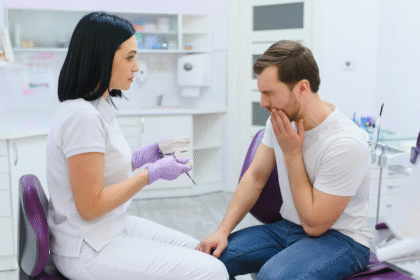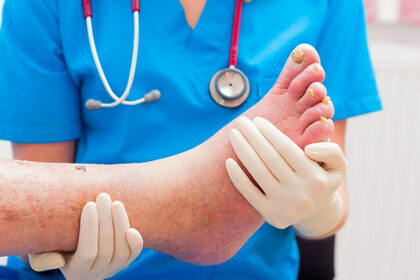Swelling in any part of the body can be worrying, but swelling in the groin, scrotum, or testicles often raises particular concern for men. It can be alarming to notice a change in size, shape, or feel especially when it comes on suddenly or doesn’t seem to be going away.
If you’ve found swelling and aren’t sure what it means, what’s worth monitoring, what needs medical attention, and which signs may point to common but treatable conditions.

Understanding Male Swelling: What’s Normal and What’s Not?
Swelling can be caused by many different things from fluid retention and inflammation to infection or injury. Some causes are harmless and may settle on their own, while others need a doctor’s input.
Let’s start with some common areas where swelling can occur and what they might mean:
1. Scrotal and Testicular Swelling
This is one of the most frequent types of swelling men experience and may be caused by:
Hydrocele
A hydrocele is a fluid-filled sac around a testicle. It’s usually painless and may make one side of the scrotum look larger or feel heavier. Hydroceles are common in newborns but can also affect adult men, particularly those over 40.
While hydroceles aren’t typically dangerous, they can grow large and uncomfortable. In some cases, they may be linked to injury or infection. You might consider natural approaches first. Many people look into hydrocele home remedies for comfort, but persistent or growing swelling should still be reviewed by a doctor.
In rare cases, especially if you experience pain, redness, or fever, it could be a sign of something more serious. Although some may wonder how to drain a hydrocele at home, this is not recommended without medical advice, as improper attempts could worsen the condition or cause infection.
Inguinal Hernia
An inguinal hernia occurs when part of the intestine pushes through a weak spot in the lower abdominal wall into the groin or scrotum. This often causes a bulge that may come and go, and might hurt when coughing, lifting, or bending over.
It’s important to seek medical attention if the swelling becomes hard, painful, or can’t be pushed back in. This may suggest a strangulated hernia, which cuts off blood supply and requires emergency surgery.
Epididymitis or Orchitis
Infections of the epididymis or testicle — known as epididymitis and orchitis — cause pain, swelling, and often redness or warmth. These are often caused by bacterial infections or sexually transmitted infections (STIs) in younger men.
You should see a doctor if the swelling is painful, sudden, or accompanied by symptoms like fever, painful urination, or discharge. Early treatment with antibiotics can prevent complications and relieve symptoms.
Testicular Torsion
This is a medical emergency. Testicular torsion occurs when a testicle twists, cutting off its blood supply. It causes sudden, severe pain and swelling, often with nausea or vomiting.
This condition requires immediate surgery. Delay in treatment can lead to permanent damage or loss of the testicle.
Testicular Cancer
Although less common, a painless swelling or lump in the testicle can sometimes be a sign of testicular cancer. It often appears as a firm area that feels different from the rest of the testicle.
Testicular cancer is highly treatable when caught early. If you notice a lump or swelling that doesn’t go away, make an appointment with your GP without delay.
2. Groin Swelling
Groin swelling in men can be caused by:
- Lymph node enlargement: This may occur in response to infection or inflammation, often presenting as small, firm lumps in the crease between your thigh and pelvis.
- Hernias: As mentioned, inguinal hernias commonly appear in this region.
- Abscess or cyst: An infected cyst or boil can form in the groin, particularly if there’s friction or poor hygiene.
Pain, warmth, redness, or pus are signs that the swelling is likely infected and needs treatment.
3. Penile Swelling
Swelling in the penis is less common but may arise from:
- Infection or inflammation, such as balanitis (inflammation of the foreskin or head of the penis)
- Injury during [removed] activity or accidents
- Allergic reactions to soaps, condoms, or personal care products
If the swelling is painful, persistent, or affects urination, speak to your GP. Sudden and painful swelling with a change in colour or loss of sensation may be a medical emergency.
4. Leg, Ankle, or Foot Swelling in Men
Although not exclusive to men, swelling in the lower limbs can point to problems such as:
- Venous insufficiency, where blood doesn’t return efficiently from the legs to the heart
- Heart or kidney issues
- Infection or cellulitis, particularly if the skin is red or warm
- Deep vein thrombosis (DVT), which may cause swelling in one leg with pain and a feeling of tightness
Any unexplained or one-sided swelling in the leg should be reviewed quickly, especially if accompanied by pain or breathing difficulty.
When Should You Worry?
Not all swelling is serious, but there are red flags you should never ignore:
- Sudden swelling, especially with pain
- Swelling with fever, redness, or warmth (signs of infection)
- Swelling that grows rapidly
- Difficulty passing urine
- Swelling with nausea or vomiting
- A testicle that feels hard or irregular
- Swelling that’s accompanied by weight loss or fatigue
It’s always best to speak to a GP if you’re unsure. Early treatment often means quicker recovery and fewer complications.
How to Check Yourself: A Simple Testicular Self-Examination
Doing a monthly self-check can help you stay on top of any changes. Here’s how:
- Do it in the shower or right after, when the scrotum is relaxed.
- Gently roll each testicle between your fingers and thumbs.
- Feel for any lumps, swelling, or changes in size or firmness.
- Check the epididymis, a soft tube at the back of each testicle. It may feel slightly lumpy but should be painless.
If something doesn’t feel right, don’t panic — but do book an appointment with your GP to get it checked.
What Can You Do at Home?
While some types of swelling require medical input, others may improve with home care. Here are a few general tips:
- Rest and avoid straining or lifting heavy objects.
- Apply a cold pack (wrapped in cloth) for 10–15 minutes to reduce inflammation.
- Wear supportive underwear, like briefs, to ease discomfort in the scrotal area.
- Keep the area clean and dry to prevent infection.
- Stay hydrated and reduce salt intake if swelling is generalised (e.g., in legs or ankles).
For testicular or scrotal swelling caused by hydrocele or minor inflammation, hydrocele home remedies such as warm baths and natural anti-inflammatory foods (like turmeric or ginger) may help with discomfort. However, these are supportive measures — not a substitute for medical evaluation.
When to See a Doctor
Contact a healthcare provider if:
- The swelling is painful or getting worse
- You notice a new lump or bump in the testicles
- The area feels warm, red, or has discharge
- You have symptoms of infection (fever, chills, burning when urinating)
- You feel unwell or experience unexplained weight loss
- Swelling doesn’t improve after a few days of rest
Even if symptoms seem mild, it’s always worth getting a professional opinion.
Summary: Key Points to Remember
- Swelling in men is common but varies in cause — from harmless fluid build-up to infection, hernia, or cancer.
- Hydroceles are a frequent cause of scrotal swelling, often painless but uncomfortable.
- Red flags include pain, fever, sudden swelling, or changes in how a testicle feels.
- Self-examination can help detect issues early — don’t wait if something feels wrong.
- Medical advice is crucial if symptoms persist, worsen, or cause concern.
Final Thought
Swelling might feel embarrassing or uncomfortable to talk about — but addressing it early is always the right move. Most causes are treatable, especially when caught early. Whether you’re dealing with discomfort, uncertainty, or simply want peace of mind, speaking to a GP is a positive step for your health and confidence.





